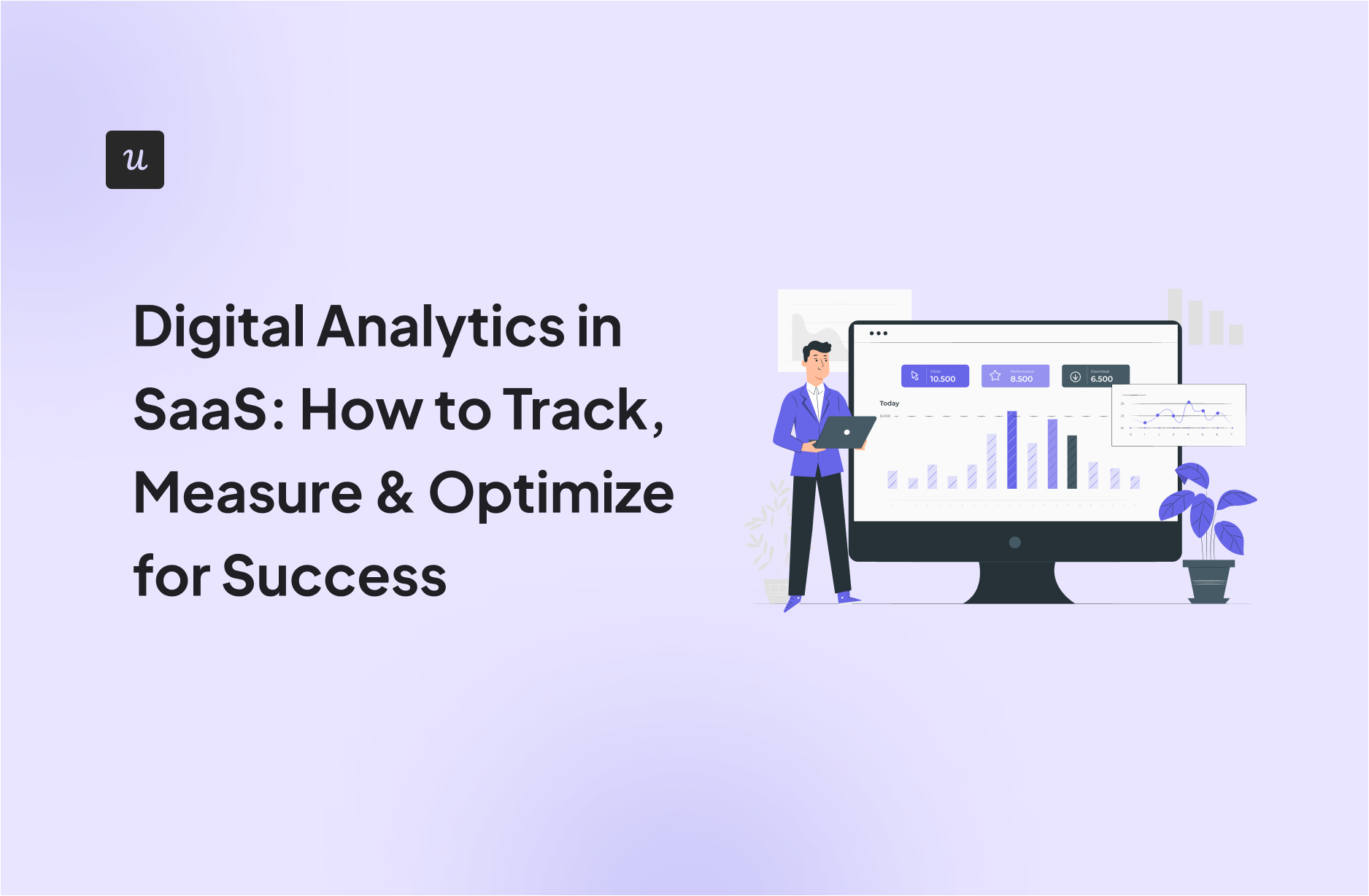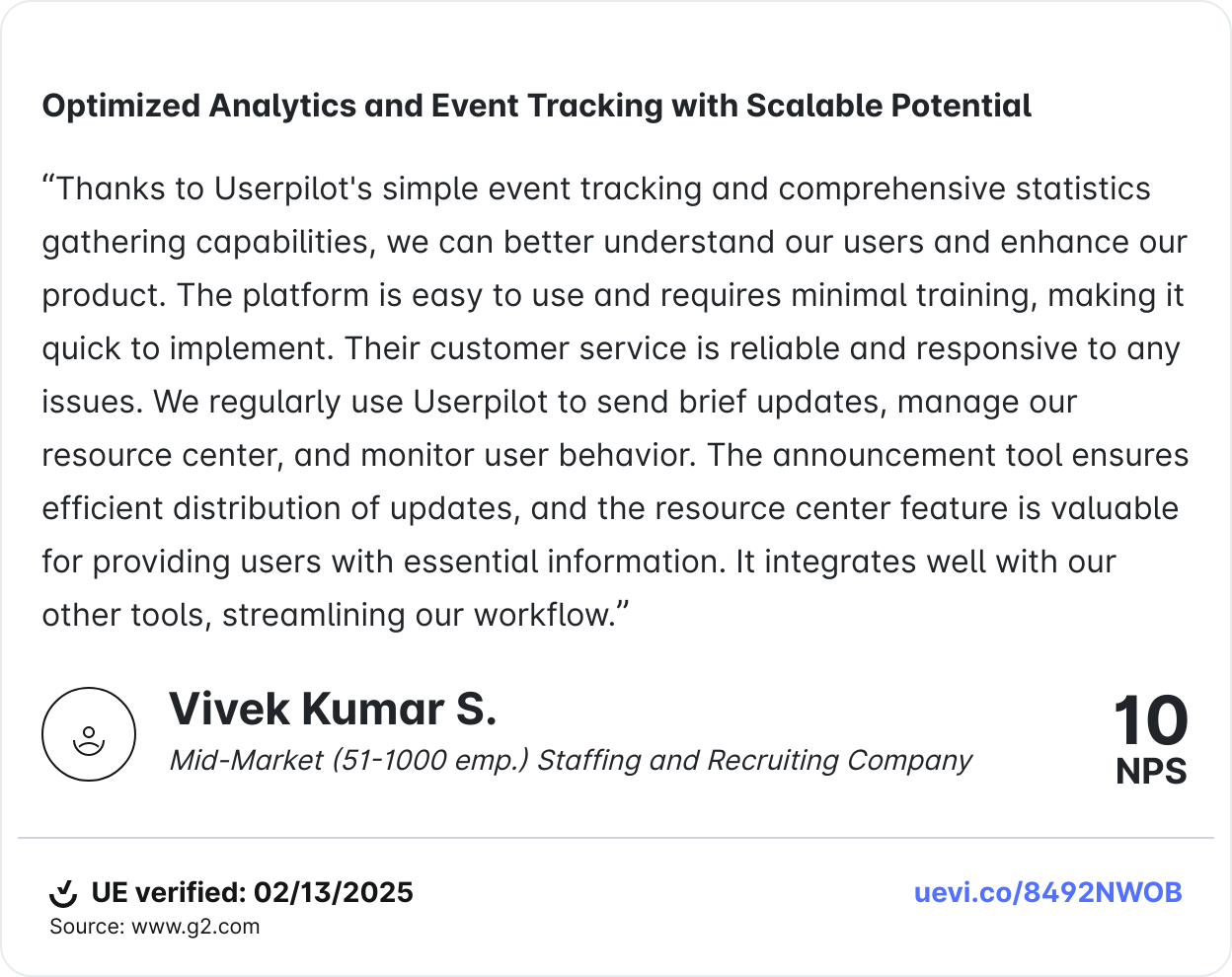
Digital Analytics in SaaS: How to Track, Measure & Optimize for Success
Without digital analytics, SaaS businesses operate blindly: missing opportunities to enhance user experience, prevent churn, and increase revenue.
By leveraging customer data, companies can track engagement, refine their products, and implement data-driven marketing strategies that fuel growth.
This guide explores the core concepts of digital analytics, its importance, practical use cases, and essential digital analytics tools.
Get The Insights!
The fastest way to learn about Product Growth, Management & Trends.
What is digital analytics?
Digital analytics involves collecting, processing, and analyzing data from various digital sources, such as websites, mobile apps, and marketing campaigns. By leveraging data analytics, businesses can track user interactions, measure engagement, and make data-driven decisions.
Key components include:
- Data Collection: Gathering behavioral data through tracking scripts, cookies, event-based tracking, and session replays.
- Data Processing: Organizing raw data into actionable insights.
- Data Analysis: Analyzing digital data, identifying patterns, trends, and user behavior insights.
- Reporting and Optimization: Using insights to refine strategies and enhance user experience.
Benefits of digital analytics
Digital analytics offers numerous benefits to businesses, including:
- Improved Decision-Making: By analyzing digital data, businesses can make informed decisions that drive growth and enhance user experience. For instance, understanding which features are most popular can guide product development and marketing strategies.
- Enhanced Customer Insights: Digital analytics provides valuable insights into user behavior, allowing for more personalized marketing efforts and better customer service.
- Increased Revenue: By optimizing marketing efforts and improving user experience, businesses can increase revenue and drive growth. For example, targeted campaigns based on user behavior data can lead to higher conversion rates and customer retention.
Why does digital analytics matter for SaaS businesses?
SaaS companies rely on digital analytics to inform their marketing strategy and:
- Improve Customer Retention: Identify churn risks and develop targeted retention strategies.
- Enhance User Experience: Analyze customer behavior to optimize UI/UX design and workflows.
- Increase Conversions: Use predictive analytics to fine-tune marketing and sales strategies.
- Optimize Pricing Strategies: Leverage data insights to determine the best pricing models.
Where is digital analytics data used?
Web analytics helps companies track performance, predict customer behavior, and enhance customer engagement.
Whether in marketing, product management, or customer success, digital analytics provides valuable insights that drive efficiency and revenue.
Let’s take a look at some use cases depending on different areas:
How SaaS companies can use digital analytics
SaaS companies rely on digital analytics to enhance product performance and customer retention.
By analyzing customer lifetime value (CLV) and user behaviors, businesses can determine the long-term value of different customer segments and tailor their strategies accordingly.
Trial-to-paid conversion tracking helps optimize the onboarding experience, increasing the likelihood of upgrades.
Additionally, feature usage analysis identifies which tools drive the most engagement, allowing product teams to refine their offerings.
Finally, churn prediction leverages predictive analytics to anticipate customer attrition, enabling proactive retention strategies.
How sales and customer support teams can use digital analytics
Digital analytics empowers sales teams by identifying high-value prospects.
Lead scoring helps prioritize leads based on engagement and intent, ensuring a more efficient sales process.
By leveraging predictive models, businesses can implement retention strategies to identify and address customers at risk of churn.
Additionally, cross-sell and upsell targeting enables sales teams to recommend relevant products based on user behavior, driving expansion revenue.
How digital marketing teams can use digital analytics
Marketers use digital analytics to measure campaign effectiveness, track user behavior, and optimize ad spend, making it a crucial part of their marketing strategies. Implementing digital analytics involves defining business goals, selecting appropriate tools, and integrating these tools into existing systems.
It enables businesses to track campaign performance by assessing the success of paid ads, social media campaigns, and email marketing efforts.
By analyzing traffic sources, marketers can identify where users originate (whether from organic search, paid ads, or referrals) to refine their marketing efforts.
Digital analytics also enhances customer segmentation, allowing businesses to group users based on demographics, interests, and behaviors for personalized marketing.
Additionally, A/B testing of landing pages and emails helps identify the best-performing variations to maximize conversions.
Lastly, optimized attribution modeling ensures marketers understand which touchpoints contribute most to conversions, allowing for better budget allocation and strategy refinement within their marketing strategies.
How product teams can use digital analytics
Understanding how users interact with your product is key to making smarter decisions about both your product and marketing strategies.
By analyzing feature adoption and usage, you can see which tools or functionalities users engage with the most, helping product management teams prioritize updates and improvements.
Tracking user engagement metrics—like active users, session duration, and task completion rates—gives you a clearer picture of how people navigate your product. If users drop off at certain points, funnel analysis can highlight where they’re losing interest, allowing product marketing teams to fine-tune messaging and optimize conversion paths.
No business wants to lose customers, which is why churn prediction is so valuable. By looking at historical user behavior and product data, you can anticipate when a customer might leave and take proactive steps to keep them engaged. Similarly, onboarding optimization helps ensure users don’t struggle to get started with your product.
Identifying common pain points and making improvements based on product analytics can lead to better adoption, stronger retention, and an overall improved user experience.
Common pitfalls and best practices for collecting and analyzing digital analytics data
Understanding digital analytics is only half the battle: avoiding common mistakes and following best practices ensures you get the most accurate and actionable insights.
Here’s what to watch out for and how to optimize your approach.
Common pitfalls to avoid
Even with the best digital analytics tools, businesses can fall into common analytics traps. Here are some mistakes to avoid when collecting and analyzing digital analytics data:
- Over-reliance on Vanity Metrics: Metrics like page views or downloads might look impressive but don’t necessarily indicate meaningful engagement or business impact.
- Poor Data Quality: Inconsistent tracking, missing data, or improperly configured analytics tools can lead to misleading insights.
- Ignoring Customer Feedback: Digital analytics provides numerical data, but qualitative insights from surveys, reviews, and customer support interactions add crucial context.
- Lack of Actionable Insights: Collecting data without a clear plan for using it can result in reports that provide no real business value.
- Failure to Segment Data: Treating all users the same can hide important insights. Proper segmentation based on demographics, behavior, and engagement levels is key.
- Not Keeping Up with Privacy Regulations: With GDPR, CCPA, and other data privacy laws, businesses need to ensure compliance when collecting and storing user data.
Best practices for effective digital analytics strategy
To maximize the impact of digital analytics, SaaS businesses should adopt these best practices:
- Define Clear Objectives: Before collecting data, establish specific business goals, such as increasing customer retention, optimizing the onboarding experience, or improving conversions.
- Ensure Data Accuracy & Consistency: Conduct regular audits of data collection processes to ensure accurate tracking across platforms.
- Use a Combination of Metrics: Combine qualitative and quantitative data to gain a complete understanding of user behavior.
- Test & Iterate: Use A/B testing and experimentation to refine product features, marketing campaigns, and user experiences.
- Leverage Predictive Analytics: Utilize machine learning models to identify patterns, predict customer churn, and implement proactive retention strategies.
- Prioritize Data Privacy & Compliance: Ensure that all analytics efforts align with data protection laws and ethical data collection practices.
What to look for in a digital analytics platform?
Choosing the right digital analytics platform is essential for SaaS companies aiming to maximize their data insights. Here are key factors to consider:
- Event-Based Tracking: Look for platforms that provide detailed event tracking to understand user interactions at every stage of the journey.
- User Segmentation: The ability to segment users based on behavior, demographics, and engagement levels is crucial for targeted actions.
- Real-Time Analytics: Fast, real-time insights allow for quick decision-making and course correction.
- Data Integration Capabilities: Ensure the platform integrates seamlessly with your CRM, marketing automation, and product analytics tools.
- Custom Dashboards and Reporting: A customizable dashboard makes it easier to track and analyze key performance indicators (KPIs).
- Privacy and Compliance: Check that the tool adheres to GDPR, CCPA, and other relevant data protection regulations.
Top digital analytics tools in the market
To effectively leverage digital analytics, businesses can use the following tools:
- Userpilot: Best for in-app analytics and tracking product adoption. Check our pricing.
- Google Analytics: Best for tracking website traffic and user demographics.
- Mixpanel: Ideal for tracking user events and retention metrics for SaaS products.
- Amplitude: Strong in product analytics and user behavior segmentation.
- Hotjar: Captures heatmaps and session recordings to analyze user interactions.
- FullStory: Enables session replays to identify friction points in the customer journey.
Examples of digital analytics in action
Beable Education improved engagement with analytics
Beable Education improved user engagement and efficiency using Userpilot’s analytics and feedback features. By leveraging features like page tagging, funnel analysis, surveys, and resource center analytics, Beable enhanced user onboarding, tracked engagement, and gathered feedback, leading to better decision-making and higher user participation.
Zoezi improved user experience and gained valuable insights from analytics
Zoezi lacked insights regarding product usage and had an inefficient help center. They chose Userpilot after analyzing Pendo, ProductFruits, and Appcues. Zoezi improved customer communication and made better product prioritization decisions after using Userpilot’s analytics, onboarding, and support features.
Conclusion
Digital analytics enables teams to make data-driven decisions and shape their product and marketing strategies based on empirical evidence.
In practice, this means tracking website, product, marketing, and feedback data with appropriate tools, analyzing their behavior, and implementing the insights.
Want to see how Userpilot helps SaaS companies optimize product adoption and user behavior? Book a personalized demo today!







